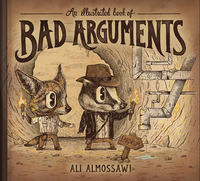You need to sign in or sign up before continuing.
Take a photo of a barcode or cover
This is a good book. No arguments. I will read it again, in fact I can read it anytime. Each chapter takes at most 5 min.
I wanted to love this. The illustrations are so dear, and the captions for each illustration make sense, but a lot of the text itself is muddled. The examples chosen weren't always the best to illustrate the topic fallacy. That said, the book is appealing and easy to read; I'm going to try to pawn it off on my visiting tween nephews as a starting point for thinking about logical reasoning.
informative
lighthearted
fast-paced
around the world ✈️ - Bahrain 🇧🇭
An informative and straightforward read on logical fallacies that we're bound to come across whether in our daily lives or in the media. Written by Ali Almossawi's and illustrated by Alejandro Giraldo, An Illustrated Book of Bad Arguments was an amusing read to help strengthen critical reasoning skills through an introduction to common pitfalls that occur in defence of rationalization. I found the no true scotsman and slippery slope fallacy to be my favourite.
An informative and straightforward read on logical fallacies that we're bound to come across whether in our daily lives or in the media. Written by Ali Almossawi's and illustrated by Alejandro Giraldo, An Illustrated Book of Bad Arguments was an amusing read to help strengthen critical reasoning skills through an introduction to common pitfalls that occur in defence of rationalization. I found the no true scotsman and slippery slope fallacy to be my favourite.
A very basic primer on logical fallacies. It's not bad, but you could probably find better.
Helpful definitions and examples of argumentative fallacies, which would be a great resource for any philosophy or composition class. The book as a stand-alone isn't too great, as it's mostly a list of vocabulary words and examples, and doesn't have tons of synthesis or overarching connection to make the examples easy to remember or organize mentally. But it would definitely be a great supplement to critical thinking and persuasive writing or speaking activities.
A cute little book on the many different ways an argument can go bad.
I was disappointed in the illustrations. They are nicely done drawings but usually failed to illustrate the fallacies well.
I particularly disliked the illustration for "Straw man" which says, "The energetic, muscular, and colorful toucan was completely misrepresented by one of the artists. Later on, he showed the audience his painting and criticized how dull and lifeless the toucan had looked."
Who showed whose painting? The toucan or the artist? The antecedents are unclear.
I particularly disliked the illustration for "Straw man" which says, "The energetic, muscular, and colorful toucan was completely misrepresented by one of the artists. Later on, he showed the audience his painting and criticized how dull and lifeless the toucan had looked."
Who showed whose painting? The toucan or the artist? The antecedents are unclear.
This book was preciously illustrated and a good tool for use with people who really don't want to learn about fallacies the old fashioned way.
informative
fast-paced



